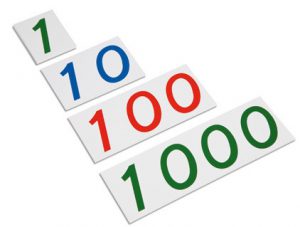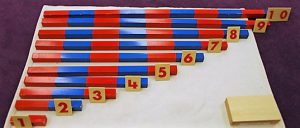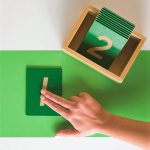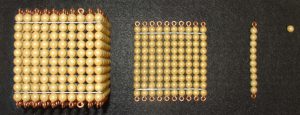The children have been happily humming along with their wonderful lessons these past few weeks. One area of interest seems to be the Math lessons. Many of the students are currently learning the basic math concepts of number recognition and retrieving quantities or they are reviewing past lessons and applying those skills within new lessons. In the next few months I would like to expand on this area of lessons to help you have a better idea of what your child is working on.
Dr. Montessori designed concrete materials to represent all types of quantities. In a Montessori environment, a child not only sees the symbols for concepts like 1, 1000, or even 1/2 but he can also hold each of these corresponding quantities in his hand.
Later on, by combining this equipment, separating it, sharing it, counting it, and comparing it, he can demonstrate to himself the basic operations of arithmetic. These kinds of activities give the child the satisfaction of learning by discovery rather than by being told. Eventually he develops an early enthusiasm for the world of numbers.
Our younger students are being introduced to numbers with our counting red and blue number rods. Each section of color represents one unit such as one red rod is a one and the next rod is one red space and one blue space which represents a two. The rest of the rods from three through ten continue on in this same fashion. We encourage the child to work with this material until they are very familiar with it by using a variety of games. In this fashion the child is given a lot of repetition and can grasp the concepts with ease. Depending on your child’s interest in working with this material these lessons can easily sustain their desire to work with it for months.
Close to this same time frame your child learns the corresponding figures by tracing the numerals using our sandpaper numbers with a completely new lesson with out the number rods. Once again there are a variety of lessons we use to keep your child’s interest. Once the number rods and the sandpaper numbers concepts are fully grasped and the child has had lots of repetition opportunities then we combine these two lessons together and just like magic the material being used becomes new and exciting to your child.
The older students also have this same kind of experience while working with the concepts they already know and applying this knowledge to new lessons such as working with the Golden Bead Decimal work. The children often are introduced to working with just the quantities of beads such as unit, ten bar, hundred square and thousand cube. The children already know the terms of square and cube from their work with the geometric materials in the Sensorial exercises in the classroom. We explain to the child that in order to count large quantities of the units is awkward and time consuming. Therefore, whenever they have ten units they exchange them for a ten bar. When they have ten ten bars they replace them with a hundred square, and whenever they have ten hundred squares they exchange them for a thousand cube.
At about the same time we also introduce just the symbols of the corresponding written cards to the children. These sets of cards are color coded according to their number families such as green units from 1-9, blue ten’s from 10-90, red hundreds from 100-900 and green thousands from 1000-9000. Your child will working through a variety of games retrieving various cards that the teacher requests. We first only work with the units until the child understands the concept. Then we will add the units and tens together such as: 3 tens and 4 units making thirty four. Once again until the child truly grasps this concept we can not go any further, however the games will continue with including hundreds and thousands as the child is capable. Many of the older afternoon students are completely involved with taking this knowledge and are now working with the various operations of math such as addition, subtraction, multiplication and division through a variety of lessons called the Bank Game. I will explain more of how this works next time.


